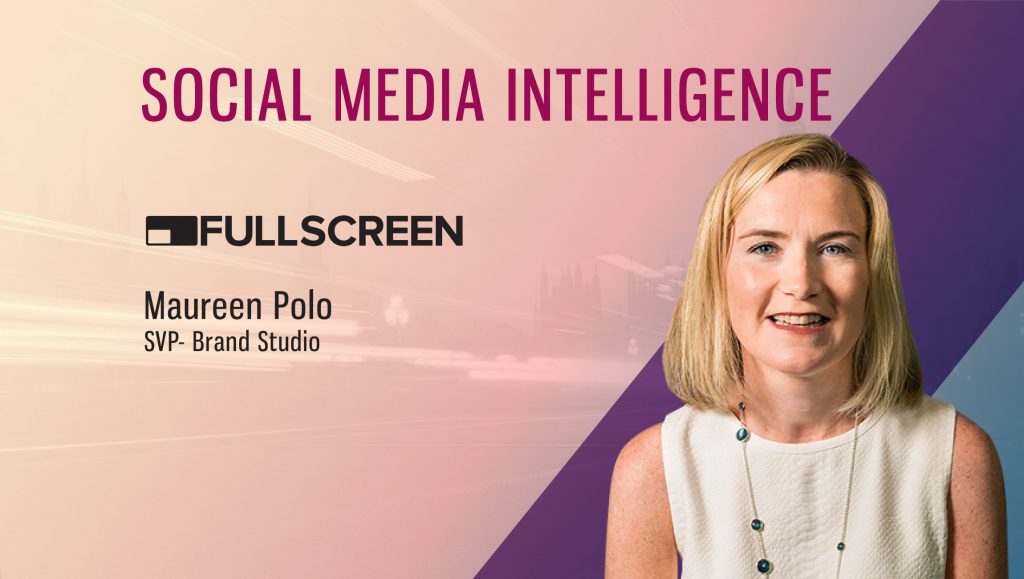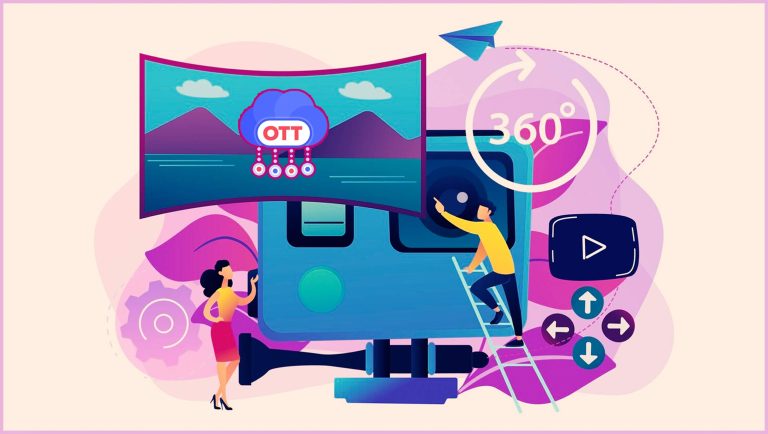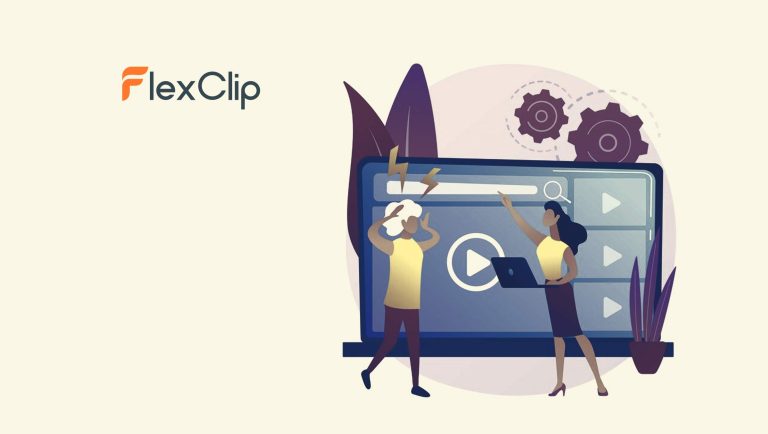
Maureen Polo,
SVP, Brand Studio, Fullscreen
Influencers could be growing in numbers but not in credibility. That’s where influencer analytics platform come into the picture and try to prove their worth. To better understand how Influencer Marketing platforms influence social media buying behaviors and the idea behind the latest report, titled “Influence by the Numbers’, we spoke to Maureen Polo, SVP, FullScreeen.
Tell us about your role at Fullscreen and the team and technology that you handle.
I am Senior Vice President, Brand Studio, leading Fullscreen’s national integrated marketing and content initiatives. My team is responsible for helping brands understand the power of influencers and developing connections with next-gen audiences through authentic, relevant storytelling and content.
What is the ‘State of Social Media Audience Intelligence’ in 2018?
Audiences, especially those that grew up in the digital age, easily tune out advertising. That’s why it’s so important for brands to take a strategic approach to their content creation, making sure content is creative, relevant, and acts as a friend to viewers. This type of thinking will go a long way in building trust and ongoing relationships with your audiences.
How could Influencer Marketing platforms influence social media buying behaviors?
Influencers have a lot of clout with their followers. Almost half (42%) of those aged 18-34 report trying a product recommended by an influencer and 26 percent say they have actually made a purchase based on a recommendation. Followers of influencers with smaller audiences (micro influencers, those with less than 250K followers) are also much more likely to try something recommended by the influencer than those who follow celebrities (20M+ followers). One reason for this is that audiences might feel like they have a more personal relationship with micro influencers, and therefore put more trust into their recommendations.
What is the message you want to give through your latest report – ‘Influence by the Numbers’?
It’s important for brands and marketers to realize that influencers are not “one size fits all.” There are a number of different buckets that influencers can fall into, and it was important for us to identify those and discover how each group fared when it came to the impact of different types of content, platform, and varying levels of trust, engagement rates, and purchase behavior on behalf of the consumer. In order to best reach key audiences, it’s crucial to understand these nuances and know what best resonates with consumers. All Influencers are not created equal- and the Fullscreen approach to influencer marketing is both an art and a science; a combination of human capital and proprietary tech/tools. There is a qualitative and quantitative evaluation of the creators we choose to bring into our network and even more scrutiny placed on the creators we recommend to our brand partners.
How do you differentiate between REAL-Human behaviors from bots in your audience data analytics? Do bot analytics impact influencer marketing results?
This is a hot topic for our industry. Spotting bots is a delicate, imprecise kind of art. At Fullscreen, we have both an automated and manual process to prevent botting. Generally though, you can notice certain trends in the analytics: the traffic sources, unrealistic views, views from certain countries, etc. Things like that are tell-tale signs of inorganic traffic due to bots. But if the channel has not been Terminated for botting by YouTube, it’s because they did it well and hid it from the sophisticated systems that YouTube now has in place to spot them.
Fullscreen rigorously vets influencers before they are accepted into the network. We accept less than 1 percent of all applicants to our network overall so we uphold very high standards, especially when selecting talent for brand partnerships. We analyze both audience make up and the personal interactions with their fans across all social platforms and can detect when digital behavior seems to shift inorganically.
At Fullscreen, influence is measured through a complex system of metrics. We select creators that have earned the trust of their audience, and building trust is earned over time so we evaluate the creators. Our sophisticated approach protects us from bot behavior that YouTube doesn’t detect already. Fullscreen does not participate in the “pay for play” model of influencer marketing. The influencers we recommend for our brand partnerships are not in the business to simply make money. They are programming for their audience – and their audience is their holy grail. Fans, not bots, propel our influencers through their journey – which becomes obvious when you examine the level of engagement and conversation that happens between an influencer and his/her fans. Our influencers are fan-made and success is built one follower at a time. They don’t take this lightly and they have a very real fear of selling out (FOSO) and disappointing their audiences; faking it isn’t in their DNA. Influencers who program for $$ are what we at Fullscreen call “the side hustlers” – and these creators care more about the paycheck than their audience. These creators don’t make it through our vetting process because they simply don’t meet Fullscreen’s qualifications.
At Fullscreen, how do you verify the authenticity of data or source of content? How does it fit impact your ability to offer higher transparency and performance?
Providing accurate and verified social analytics data is not only important to Fullscreen, but is a critical component for how marketers, agencies, and publishers can build a transparent and transactional marketplace. At Fullscreen, we employ both homegrown solutions alongside strategic third-party partnerships to ensure that the metrics we are sharing back with clients are vetted and accurate. These include:
- Detection of Fraudulent Activity on Organic Social Content:
- Flagging of a Digital Creators’ organic content: This is triggered by three important factors (1) Creator audience country reach that over-indexes against the norm (2) Creator platform-by-platform subscriber growth rates that index over average (3) Creator platform engagement rates much lower than the average.
- Additional layers of security from Fullscreen Shield. This includes (1) Analysis of comments for bot-like posts such as unnatural links, foreign languages not aligned with the influencer’s language, and graphic or pornographic content (2) Analyzing engagement rates and flag content that over-indexes against the norm (3) Creating and maintaining a dynamic blacklist for known offenders.
- Detection of Fraudulent Activity on Paid Media:
- Fullscreen partners with industry leader MOAT, which uses a proprietary and exhaustive methodology for invalid traffic detection. Additionally, Fullscreen’s media buys on Youtube are similarly and additionally tracked with both automated systems and human reviews to ensure the detection, flagging, and prevention of invalid traffic.
- Strong Third-Party Partnerships: We partner with third-party analytics firms across the Social Media and Digital landscape, which all utilize similar, proprietary detection tools for industry-wide social accounts and digital properties.
How would you define Personalization- Segmentation- Optimization, and Automation at various stages of Customer Lifecycle? How do you manage customer experiences at each level of this journey across social?
Personalization requires a data-driven approach to content creation: audience segmentation, behavioral data, and channel performance are all critical to the personalization process. And there is no doubt that personalization works. Consumers feel more affinity toward brands who deliver a tailored experience and they also spend more with those brands. It drives impulse purchases (49% buy items they didn’t intend to buy because of personalized recommendations). Personalization leads to increased revenue overall (40% of consumers have purchased something more expensive than they planned due to personalization). Personalization also leads to loyalty (44% of consumers say they will likely repeat purchase after a personalized experience).
Marketers are really leaning into personalization. 88 percent of marketers say they’ve realized a measurable lift in business results from their personalized campaigns and nearly all (96%) of marketers agree personalization advances customer relationships. We are not in a marketing era where personalization is optional; we now have to ask ourselves, “how far can we push?” We want to keep consumers engaging with our brand partners for a greater duration with more intense engagement, and that means delivering a relevant experience at each touchpoint.
At Fullscreen, personalization is the ability to specifically message an audience based on what brand messaging they’ve been exposed to previously, what affinities they have or fandoms they are a part of, or where they are in a purchase cycle. This can be done in a variety of ways, whether it’s segmenting audience buckets by who has been exposed to your ad previously and serving them a sequentially based ad or adjusting your ad copy and imagery/video to tap into the audience’s affinities/fandoms or where they are in the purchase funnel (e.g. brand messaging vs. offers). This is all done with a layer of optimization and automation that allows us to hone in on what tactics, based on our objectives, are performing best and acting on this information quickly.
What are your predictions for marketing technologies for influencers in 2018-2022?
If I had to make two predictions on the business side of influencer marketing, I would say technology will offer more sophisticated means to both scale and measure the success of influencer marketing programs. Marketers will start to link their influencer marketing results with their performance data and will create models that predict and measure sales lift and ROI.
If I were making a prediction on the digital creator side of the equation, I would say technology will help them drive more meaningful engagement. They will begin to really embrace themselves as the “new media” and will want to learn more about their audience and understand how they can meet the needs of their audiences, which will cause them to start leveraging tech platforms and audience data themselves.
Thanks for chatting with us, Maureen.
Stay tuned for more insights on marketing technologies. To participate in our Tech Bytes program, email us at news@martechseries-67ee47.ingress-bonde.easywp.com
























